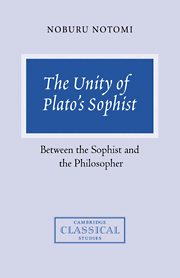Book contents
- Frontmatter
- Dedication
- Contents
- Preface
- Notes and abbreviations
- Division of the Sophist
- 1 How to read the Sophist
- 2 The sophist and the philosopher
- 3 How the sophist appears
- 4 Analysis of the structure of appearance
- 5 Appearance and image
- 6 The sophistic counter-attack on philosophy
- 7 The philosophic defence against sophistry
- 8 The final definition of the sophist
- Bibliography
- Index locorum
- General index
4 - Analysis of the structure of appearance
Published online by Cambridge University Press: 05 June 2014
- Frontmatter
- Dedication
- Contents
- Preface
- Notes and abbreviations
- Division of the Sophist
- 1 How to read the Sophist
- 2 The sophist and the philosopher
- 3 How the sophist appears
- 4 Analysis of the structure of appearance
- 5 Appearance and image
- 6 The sophistic counter-attack on philosophy
- 7 The philosophic defence against sophistry
- 8 The final definition of the sophist
- Bibliography
- Index locorum
- General index
Summary
Analysing the appearance of the sophist
Now that appearing to be wise proves to be the essential feature of the sophist's art, our next task should be to analyse and explicate, philosophically and systematically, the appearance with which the sophist is concerned. The question is what makes his appearing possible. Since the appearance is at once what the sophist displays by his art and what the inquiry has revealed, to analyse the mechanism of the appearing of the sophist and to reveal the secret of his power, which lies between being an art and non-art, will indicate how the inquiry can deal with the appearance. The inquiry in the first Outer Part has two stages of analysis. First, the New Attempt (232b1–233d2), in the course of focusing on the sophist's appearing, reveals some central features of appearing; second, the division of image-making (233d3–236d8), which follows the New Attempt, illustrates how the two ways of dealing with appearances are to be distinguished. This chapter examines the first stage and the next chapter will discuss the second.
To interpret the conclusion of the New Attempt (Passage 9), we must elucidate the complex phenomenon of the sophist's appearing to be wise. To grasp its exact meaning, we shall consider three distinctions, which the inquiry has illuminated through the New Attempt.
First, so far we have been focusing on the speaking activity of the sophist, but in order to observe his art precisely, the complex nature of controverting (antilegein) should be examined instead of the simple activity of speaking (legein).
- Type
- Chapter
- Information
- The Unity of Plato's SophistBetween the Sophist and the Philosopher, pp. 95 - 121Publisher: Cambridge University PressPrint publication year: 1999



